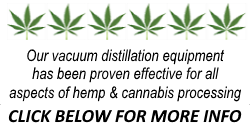The Rotor 15 is a complete distillation system including all pumping, heating, vacuum generating and control equipment needed for single stage plant operation.
The small amount of floor space occupied by the unit helps make the ROTOR 15 a most attractive system. The conveniently located side mounted control center provides for setting, readout and control of operational parameters.
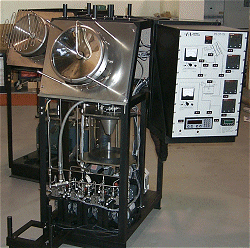 The ROTOR 15 is designed for throughputs up to 80 pounds/hr (36 kg/hr) depending on feed material characteristics.
The ROTOR 15 is designed for throughputs up to 80 pounds/hr (36 kg/hr) depending on feed material characteristics.
The major advantages to be expected from the ROTOR 15 Molecular Still are:
1. High product percentage yield.
2. Elimination of color bodies.
3. Elimination of odor fractions.
4. Minimized thermal hazard (a necessity for heat sensitive compounds).
The ROTOR 15 is designed to continuously distill thermally sensitive compounds in the molecular weight at pressures from .050 Torr to Atmosphere
Principle Advantages
The advantage of this system is that material is spread on an exponentially increasing surface area and a low pressure (vacuum) with short residence time requiring less energy and reducing thermal hazards.
Glass construction on the distillation chamber allows for easy viewing of the process as it occurs. Material is fed to the center of a rotating disk. As the material fills the center, the heavier molecules are thrown by centrifugal force to the outside at a faster rate than the lighter molecules. This gives the lighter molecules more time to absorb the heat energy and leave the surface.
The surface area increases exponentially as material travels to the outside as compared to other of stills with linear surface area. The lower pressure developed by the vacuum pump, lowers the boiling point of the material. This combined with the exponentially increasing surface area, distills material at the most efficient rate per area of distilling surface. Thus, there is minimal time for decomposition.
Because Myers Spinning Disk Technology replaces the material on evaporator heated surface at rate of 8 to 10 times faster than Wiped Film and similar techniques, significantly less surface area is required.
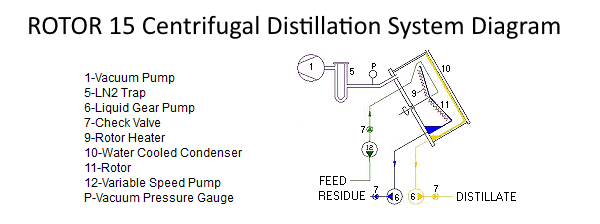
Control Center
All of the readouts and controls are conveniently grouped on the control panel mounted on the still frame.
The PLC Touch Screen control center offers displays of the vacuum , the actual and set point temperatures of the rotor feed line, the rotor heater, residue line heater and distillate line heater.
Actual and set points of all vacuum pumps and feed pumps are displayed here.
All electrical circuits are protected by fuses.
The ROTOR 15 Control Center controls and displays the following:
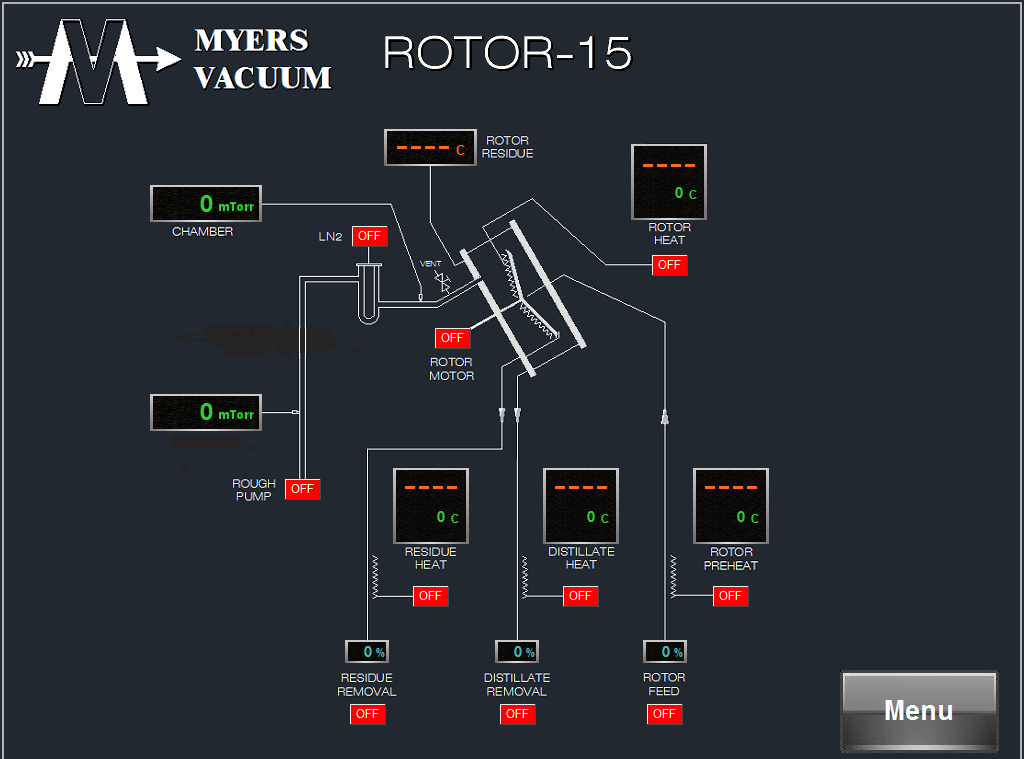 Actual and set point temperature of the material in the rotor feed line.
Actual and set point temperature of the material in the rotor feed line.- Actual and set point temperature of the rotor heater.
- Actual and set point temperature of the residue and distillate removal lines
- Rotor residue temperature.
- Pressure of the distillation chamber.
- Pressure of the vacuum pump.
- Screen control of the of liquid transfer and vacuum pumps
- Display of liquid transfer and vacuum pump status and setting
The operator controls the process by setting the feedstock rate (How thick the material will be on the rotor) and the rotor heater temperature.
Equipment in Detail
The ROTOR 15 receives material from feed tank via a variable speed feed pump which controls the feed rate through system. From the feed pump the material passes to the distillation chamber. In the distillation chamber the material is introduced into the center of the heated spinning rotocone and is spread across the heated surface. By selection of the appropriate temperature and pressure combination part of the material will separate into a vapor phase, the distillate which is condensed on a water cooled surface and flows down the chamber walls and out to the distillate pump. The remaining material (residue) passes across the full surface of the Rotocone, is collected in a surrounding gutter and flows out of the chamber via the residue pump. On the exit of each pump is a non- return valve to isolate the distillation chamber from atmospheric pressure.
The distillation chamber is pumped by an oil sealed rotary vane pump with KF fittings for quick/easy maintenance.
System pressure is monitored at the distillation chamber.
Options Available
- Liquid Nitrogen Trap emptying Module that can be connected to the Trap drain to allow emptying of trap contents while running
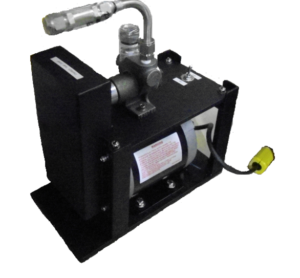
- Automatic liquid nitrogen filling – Senses LN2 level and automatically fills the liquid nitrogen traps.
- Stainless Steel Traps – Glass Liquid Nitrogen trap can be replaced with Stainless steel.
- Multi coolant Stainless steel insets can be installed in above traps.
- Stainless Steel Liquid Transfer Pumps
- High Vacuum Pump KSM 200 – This is typically used when the Rotor 15 is used in series with a Pilot 15 to complete process at second temperature. The output of Pilot 15 is feed direct to Rotor 15.
Standard Items Provided on the ROTOR 15 Still
- PLC Touch Screen controls
- SCR power regulators for Rotor heater, rotor feed line, residue removal line and distillate removal line.
- Feed system: Three (3) variable speed pump gear pumps.
- Stainless steel vacuum manifolds with glass trap.
- Powder coated frame and mounting brackets
- Completely frame mounted
- Materials in contract with the process material are either 316 stainless steel or glass.
- Stainless Steel tubing and check valves
- Rotary vacuum pump.
User Provided Equipment
The ROTOR-15 is a very complete unit, hence the only external requirements in addition to power, low pressure air, and water are:
- Suitable storage tank for the Feed Stocks.
- Suitable tanks to collect Distillate and Residue.
- Suitable cooling media for trap.

